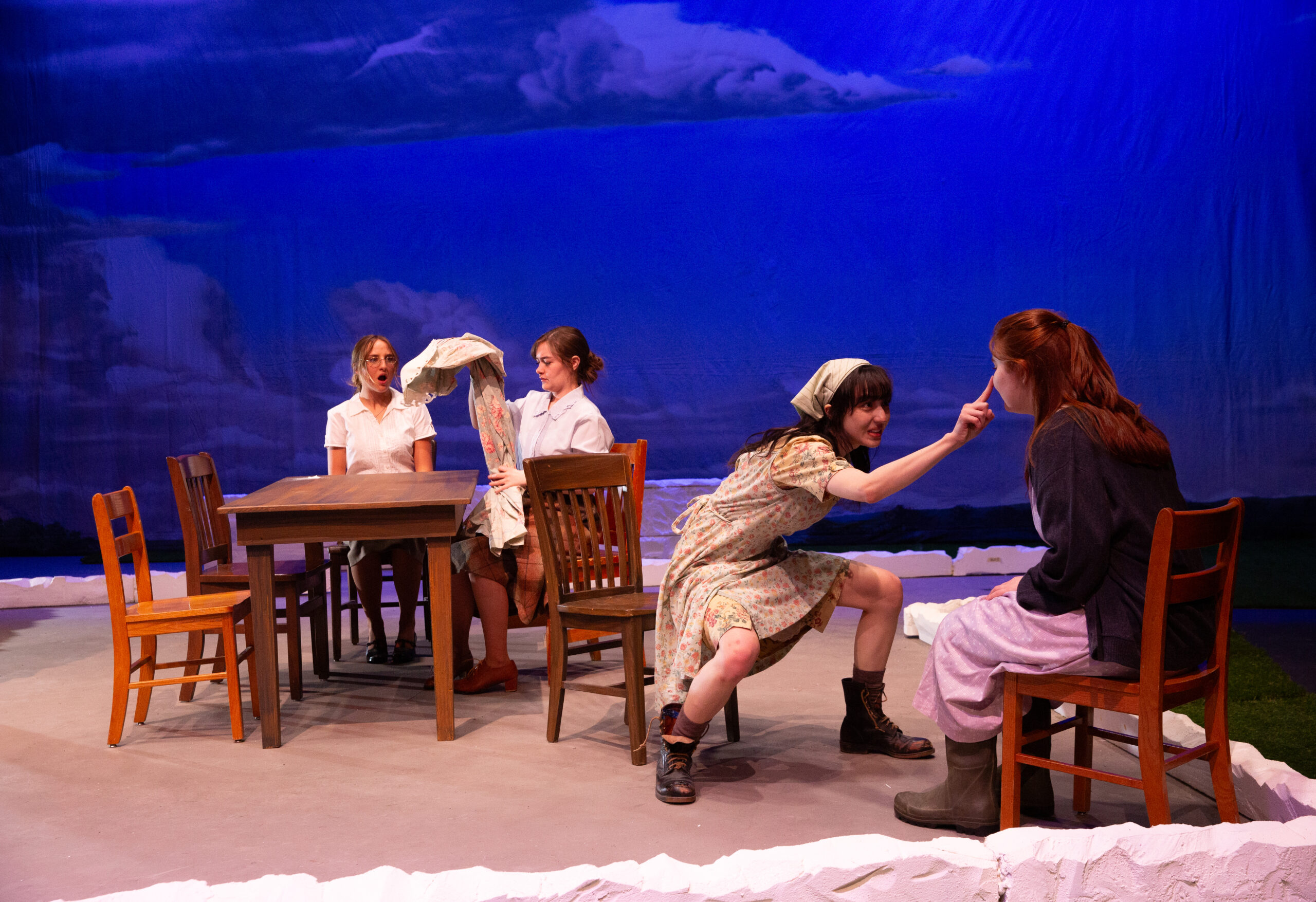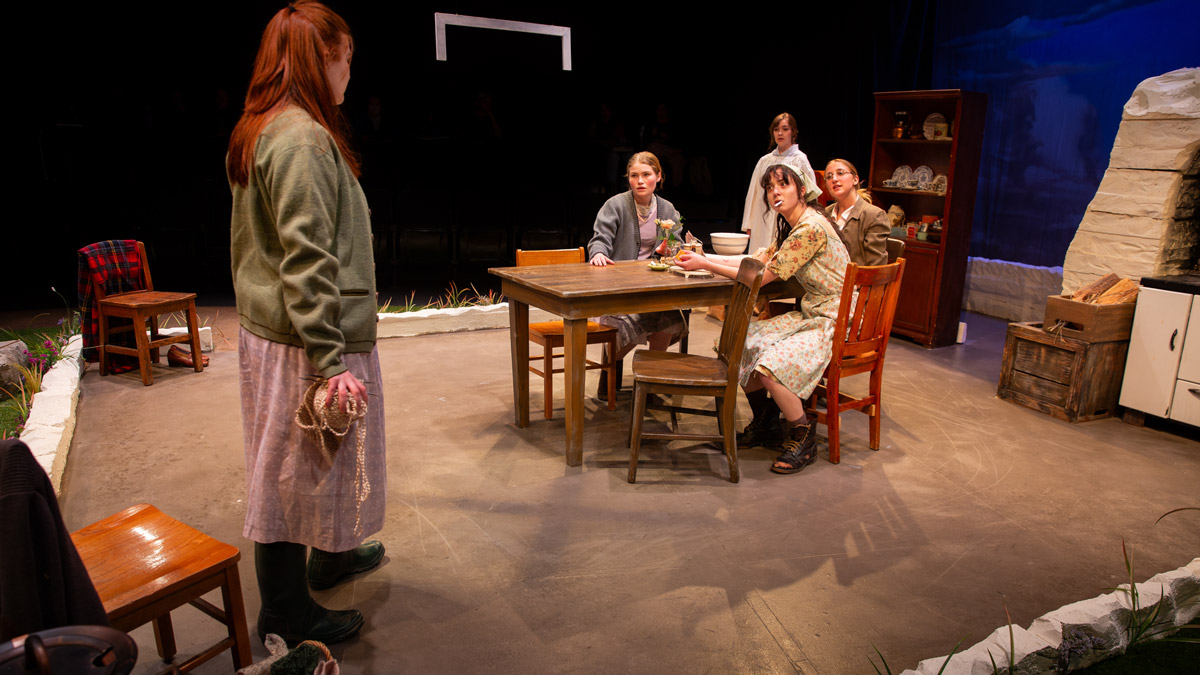SALT LAKE CITY — On Friday, March 15th, 2024 I saw Dancing at Lughnasa (written by Brian Friel) and directed by Sarah Shippobotham at the University of Utah’s Performing Acts Building. Dancing at Lughnasa looks at the Catholicism of Ireland versus pagan rituals both inside and outside the country — a theme that is woven brilliantly throughout the play, but really comes together after watching the entire performance.
Even though every play is a sum of its parts, I walked away enjoying individual parts of this production the most — particularly the lighting design of Aaron Hoenig. The lighting really stood out as it guided the play and taught what to pay attention to, such as when Michael Evans (played by James Sterling Barton) — the narrator of the play — is highlighted by a spotlight whenever he comes out, often off-stage. Instead of having an actor play a younger version of himself, everyone pantomimes while he responds off-stage. There’s something both unnerving but ingenious about this and every time it happened, it caused me to marvel at the playwright’s ability and the choice to do this instead of creating a whole new role for the younger version of Michael.
Another magnificent aspect of Hoenig’s lighting was when characters transitioned from outside to inside the family cottage. (The home, by scenic designer Sara Clark, featured low whitewashed walls made of painted Styrofoam, and made up the bulk of the set.) The best use of this was when Gerry Evans (played by Jordan Palmer), the former lover of Christina Mundy (played by Aly Carter) and father of Michael Evans, comes to visit Chris. The sisters are in the house, aghast at his arrival — since Gerry is an absentee father — and Kate (played by CoCo May Berwald) is beset with rage at his visit. The lights are dark in the kitchen (designed by Sara Clark) while Chris and Gerry flirt outside. But as the play transitions to the house, the outside lights darken, and the inside ones brighten. This was a brilliant way to show the audience where to focus their attention, which part of the set is important and which characters are central in that moment.
While I’m no expert on early 20th century Irish fashion, the costuming certainly indicated the personality of each character. Maggie (played by Caro Ciet), who borders on the unhinged, is the funniest character in the show and stomps around in unlaced, brown boots. Kate is particularly stern and dressed in a long beige skirt with a white shirt under a sensible brown jacket. Rose Mundy (played by Zoe Lupcho) wears dark green rain boots in the house, Agnes (played by Maggie Goble) wears thick, dark brown socks, and Christina is the least distinctive with a long patterned skirt and soft blue top. No one changes clothes throughout the two and half hour performance which is refreshing since it did feel like a struggle to keep up with who was who, even until the end of the play.

The play’s theme of religion comes through strongest in Father Jack Mundy, who lived in Uganda for many years helping lepers, and his eldest sister Kate Mundy, a local teacher. Jack seemed to be suffering from an unnamed ailment that made him forget things, but as the play goes on he recounts his time in Africa and the many traditions and ceremonies he witnessed. In one scene, he tells the Mundy sisters about the polygamy there, and how a man can take multiple wives and how they and their children live in a type of commune together. This frustrates Kate, the play’s main pusher of Catholicism’s ideals, and confronts Father Jack about how the Bible rejects this. At another point, Father Jack asks if Michael is Christina’s love child (once he learns she was never married to Gerry) which causes Kate to explode at him, upset about any inference of Chris having had a love child.
Sound design by Joel Thompson included ambient bird sounds (though not consistently applied), chickens and the radio, which is practically a character on its own. Music is a big part of the play — characters begin singing unprompted and the radio plays intermittently. At one point, the music prompts all the women to become feral as they dance throughout the set, roaring and howling at one another, and as soon as the music turns off, they go back to normal (choreography was by Constance Anderson). Thompson’s design created a grounded realism that can draw audience members deeper into the play’s world.
Shippobotham’s experience as a dialect coach for feature films and professional theatre came through strongly as cast members delivered excellent accent work. Barton delivered a particularly noteworthy vocal performance as the play’s narrator, and had a lovely Irish brogue. The vocal work of Goble as middle sister Agnes also stood out among an entire cast who had clearly put immense time and effort into their dialects.
Ultimately, I enjoyed Dancing at Lughnasa‘s interest in religion (such as when Father Jack explained how in Africa, there’s no difference between the secular and sacred) and how the pre-Christian pagan harvest festival of Lughnasa is talked about throughout the play, much to the stridently Catholic Kate’s displeasure. The only continual wrinkle was that, as both narrator and character, Michael Evans’ role seemed confounding. He offered background information about his family that isn’t depicted in the play, but didn’t seem to really add to what’s on stage either. For example, when Rose was interested in a married man, Michael doesn’t elaborate on it in his monologues and the play leaves the situation open-ended. I found the play itself to be very well made, the actors were pleasant to both watch and listen to and the themes of the play are of personal interest. If the University of Utah chooses to produce more works by Brian Friel (or other notable Irish playwrights) perhaps I’ll find the play that speaks directly to my heart.
[box]Dancing at Lughnasa plays March 15th to the 24 at 7:30 PM at the PAB Studio 115 on the campus of the University of Utah. Tickets are $0-17.50. For more information, visit theatre.utah.edu.[/box]

